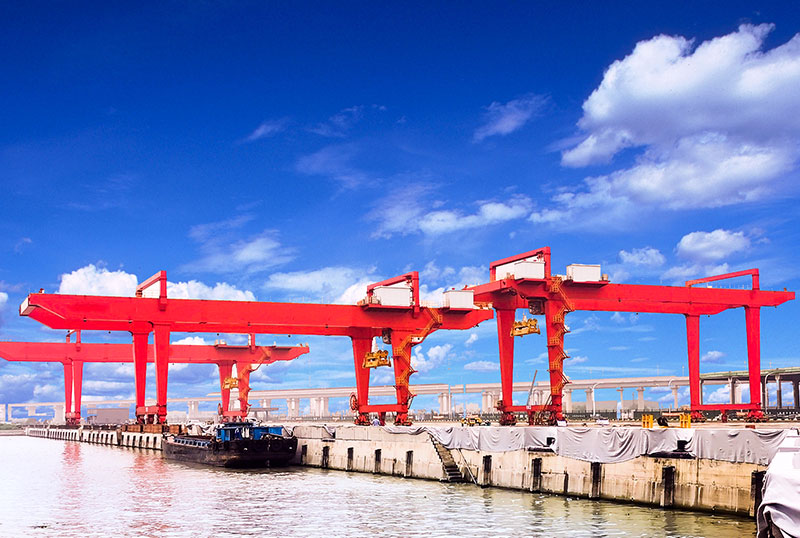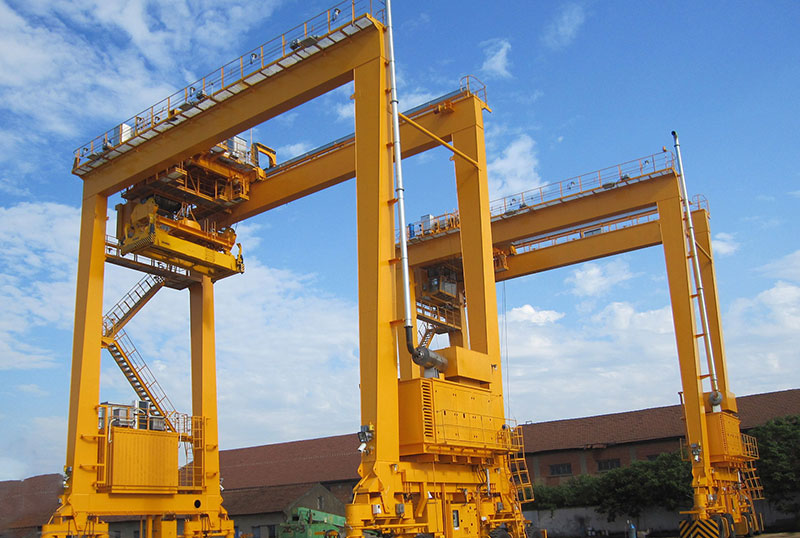Container handling gantry cranes, such as rail mounted gantry cranes (RMGs) and rubber tyred gantry cranes (RTGs), are critical infrastructure in modern ports and container yards. Their structural design is central to their performance, efficiency, and safety. As containerized shipping continues to drive global trade, the demand for robust, efficient, and reliable crane structures has never been higher.
This article explores the key structural features of container handling gantry cranes, examining their framework, materials, design standards, components, and customization aspects that make them suitable for high-volume container movement.

1. Overall Structural Framework
The main structure of a container gantry crane includes the main beams (girders), supporting legs, trolley rails, trolley frame, lifting system, and wheel assemblies. The structure must be capable of supporting massive loads while remaining stable and operational in a variety of environmental conditions.
a. Gantry Frame (Portal Structure)
At the heart of the crane is the gantry frame, which typically forms an inverted U-shape:
-
Double box-type girders span the width of the container lane.
-
Vertical legs or supports hold the girders and distribute loads to the ground or rails.
-
The legs may be vertical or inclined, depending on design preferences, operational needs, and yard space.
This robust design ensures maximum load-bearing strength, while also accommodating the passage of trucks, trailers, and other yard equipment underneath.
2. Structural Material Considerations
Container gantry cranes must be engineered from high-strength structural steel to withstand the repeated stress of lifting full containers – often 40 or 45 feet long and weighing up to 40-60 tons. The materials used are typically:
-
Q345B, Q345D, Q345E (Chinese standards) or
-
S355JR, S355J2+N (European equivalents)
These materials offer excellent yield strength, weldability, and fatigue resistance, which are vital for long-term durability under cyclic loading.
Additionally, surface protection such as galvanization, epoxy coatings, or marine-grade paint systems is used to combat corrosion in salt-laden port environments.

3. Main Beam (Girder) Structure
The main beam of a container gantry crane carries the trolley and hoisting mechanism. It must support dynamic and static loads and provide enough rigidity to limit deflection.
Key Features:
-
Box girder design: Most container gantry cranes use welded box girders for their high torsional resistance and structural stiffness.
-
Trolley rail integration: Trolley rails are mounted or integrated on the top of the girder to guide the movement of the hoisting trolley.
-
Access platforms and guardrails: Maintenance platforms are built alongside the main girders for routine inspection and servicing.
4. Supporting Legs and Bogie Structure
The legs of the crane play a critical role in transferring loads from the girder to the ground. Their structural design varies depending on whether the crane is rail-mounted or rubber-tyred.
For RMG Cranes:
-
Legs of rail mounted cranes are often welded box sections, connected rigidly to the girder.
-
One leg may be rigid while the other is flexible (pinned or hinged) to absorb deflection due to uneven rail alignment.
For RTG Cranes:
-
Legs are mounted on a mobile wheel bogie system with hydraulic or electric steering.
-
RTG rubber tired gantry crane structures often include telescopic or articulated components to enable turning and alignment.
All leg structures are designed to minimize sway and torsional movement under lateral forces like wind or sudden braking.
5. Trolley and Hoisting Mechanism Integration
While the trolley and hoist system is not part of the static structure, its integration with the structural design is crucial:
-
Trolley rails are precisely aligned along the main beam.
-
The structural frame must accommodate cable trays, festoon systems, or energy chains for power supply.
-
Trolley load is distributed via wheels and buffer systems to reduce impact and stress on the girder.
6. Structural Design for Load Handling
Container gantry cranes must be engineered to lift 20ft, 40ft, and 45ft containers, both singly and in tandem (with spreaders). Key structural load considerations include:
-
Vertical lifting force
-
Lateral wind loads
-
Seismic loads (in earthquake-prone areas)
-
Dynamic braking forces
Modern designs often undergo Finite Element Analysis (FEA) to simulate stress distribution and ensure the structure can withstand extreme loading scenarios without fatigue or buckling.
7. Stability and Anti-Sway Features
The structural system must be inherently stable and capable of minimizing sway. This is achieved by:
-
Wide base designs: A wide track gauge increases lateral stability.
-
Rigid cross beams: Strengthen the leg connection and prevent torsion.
-
Anti-sway mechanisms: Though electromechanical in nature, they rely on the precise geometry of the gantry crane structure for effective performance.
8. Modular and Prefabricated Design
Many container gantry cranes are now built with modular steel structures, allowing:
-
Easier transport and on-site assembly
-
Standardization of parts
-
Reduced fabrication and erection time
Large structural sections (legs, girders, trolleys) are prefabricated and tested before shipment and joined on-site using bolted or welded connections.
9. Structural Maintenance and Access
Good crane design includes features for inspection and maintenance access:
-
Stairs, ladders, walkways, and handrails are integrated into the structural frame.
-
Inspection hatches and platforms are provided along the girder and trolley system.
-
Structures are painted in high-visibility colors and coated with anti-slip materials for safety.
10. Design Standards and Certifications
Structural design of container handling gantry cranes must comply with international standards such as:
-
FEM (Fédération Européenne de la Manutention)
-
ISO (International Organization for Standardization)
-
GB/T (Chinese National Standards)
-
DIN, AWS, or ANSI standards for welding, structural analysis, and safety
Compliance ensures the reliability, safety, and longevity of the crane in port operations.
Conclusion
The structural features of container handling gantry cranes are the backbone of their safe and efficient operation. From box girders and steel frames to support legs and anti-sway mechanisms, every structural detail plays a role in performance, durability, and operator safety.
With the continuous growth of global trade and the need for faster container handling, future crane structures are expected to be lighter, smarter, and more energy-efficient, without compromising the strength and reliability that ports demand.
Whether it’s a rail mounted gantry crane moving stacks of containers across a terminal or a rubber tyred gantry crane navigating between aisles, the structural integrity of these machines remains a top priority – and a fascinating area of engineering innovation.